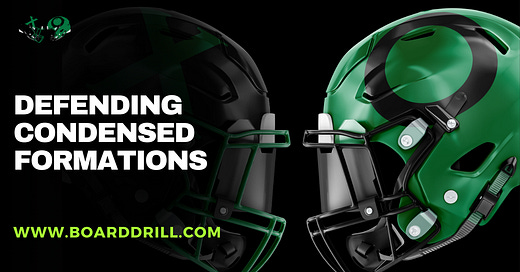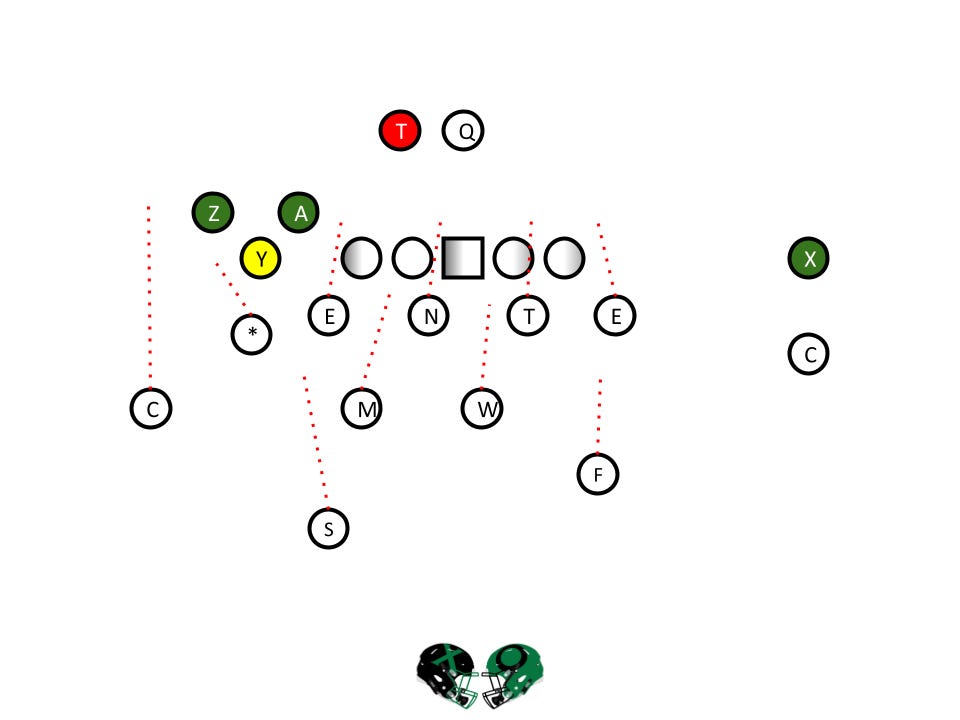Occasionally, coaches reach out and ask if we can write an article or create a video on a specific topic. Our answer is always yes—and if we don’t have the answers, we’ll go find them for you. Recently, an offensive coach asked us to break down how to defend condensed sets, noting that there’s not much content out there on how defenses can handle them. So here we go: an entire article dedicated to defending condensed offensive formations.
There are several ways to defend condensed formations, but it all starts with understanding the situation and building a game plan.
What is the offense trying to accomplish?
Are they looking to run or pass out of these sets?
What’s the down, distance, field position, and other situational factors?
Once we understand the offensive intent and the context, we can begin crafting a defensive game plan. In this article, we’ll outline various strategies for attacking condensed sets. We’ll start with run fits, then move on to coverages, and finally, what we all love most, pressures.
Run Fits
As we discussed in a recent podcast with recent podcasts with Coach Michael Rubino, offenses use condensed sets to create advantageous blocking angles, especially by allowing smaller players, like receivers, to get favorable angles on bigger defenders, such as linebackers or defensive ends. Because of this, it’s crucial for your players, particularly the defensive backs, to clearly understand their roles as force or support defenders.
In this example, the Jaguars’ Nickel does an excellent job fitting the run after traveling with the motion. Because the Nickel comes from the opposite side of the field, the Dolphins struggle to account for him in their run scheme.
In this example, the 3-tech does a fantastic job of compressing the kick block by the tight end, forcing the runner back into the pursuit.
As we’ll discuss below, corner pressure is particularly effective against condensed sets for a few reasons. First, it gives your corner an advantage by allowing them to play downhill and aggressively. In my experience, it’s much easier for a corner to make a tackle coming downhill at full speed rather than serving as a force or fold player. Second, the immediacy of the pressure can catch the offense off guard, either because they didn’t initially account for the corner or they have a late blocker trying to get to him. We often hear on our podcast, “Make the corner tackle.” Well, if you want him to tackle, put him in an advantageous position.
Pass Game
For this article, we’ll break down some of the most common pass concepts used out of condensed sets: mesh, fast to the flat, and shot plays.
At a minimum, your players should understand how to match coverage to each of these concepts when facing condensed formations. Additionally, it’s crucial to have a diverse set of coverages ready. If you consistently play the same coverage, like Cover 3, against condensed sets, you risk becoming an easy target for the offense. They’ll be ready with a Cover 3 beater in their playbook.
Coverages
Cover 3
I’m usually a Rip/Liz acolyte, but even in Rip/Liz coverage, we make an “Area” call against any stack or bunch sets.
When running Cover 3, I prefer weak rotation, primarily for better run fits but also to evenly distribute defensive backs on both sides of the formation. In this example against mesh, the Star and Free Safety would eventually match the mesh routes, while the interior backers would handle the big spot. If the running back released to the flat instead of running a rail route, the Mike and Will would work with the Star to push their coverage responsibilities toward the running back.







